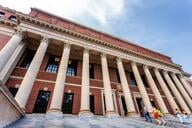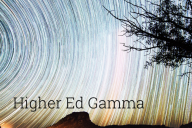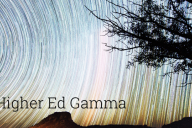You have /5 articles left.
Sign up for a free account or log in.
Are you old enough to remember The Reader’s Digest’s most popular feature: “The Most Unforgettable Character I Ever Met”?
When I was a callow 19, I had the incredible good fortune met three truly unforgettable geniuses: Arna Bontemps, Aaron Douglas and Georgia O’Keeffe.
I had embarked on a senior thesis on Jean Toomer, the recently reclaimed Harlem Renaissance poet and author. Raised largely by his grandfather P. B. S. Pinchback—who, for 30 days during Reconstruction was this nation’s first Black governor (of Louisiana)—Toomer later forswore racial identities and embraced the philosophy of the mystic Georges Gurdjieff.
That year was in many respects my annus mirabilis, a truly magical opportunity to work in the Fisk University archives, live with incredible Fisk dorm mates including a Fisk Jubilee singer, and spend my spare time with Arna Bontemps, the poet, novelist and biographer, who shared his memories of Langston Hughes and other Harlem Renaissance figures, and with Aaron Douglas, the muralist (some of whose great works were hidden behind Sheetrock in Fisk’s administration building), who talked at length about his mystical beliefs.
Then, it was absolutely thrilling when Georgia O’Keeffe, the greatest of American modernist painters, invited me to visit her New Mexico ranch. For over half a century, no one had mentioned Toomer’s name and she said she’d welcome the chance to speak about him.
Since I was too young to rent a car, I hitchhiked from Santa Fe to Abiquiu. When I arrived, scruffy and unkempt, the then 85-year-old artist met me at her door with the words “A lot of stray things used to wander in. I see they still do.”
For all the marvels of my later life—attending the Watergate hearings and listening to the rich, deep, resonant voice of Barbara Jordan or studying at the epicenter of Deconstruction during its formative years—few experiences outside of family life would truly match the wonders of my 19th year.
Still, out of the many unforgettable characters I’ve had the enormous privilege of interacting with, one who stands out was the late Peter Marzio, who directed the Museum of Fine Arts, Houston, for nearly 30 years. A born impresario, he believed in his heart and soul that his museum should serve as the city’s cultural heart. To that end, he displayed high school students’ art, held dance parties in the museum’s foyer and allowed community groups to host receptions at the museum at no charge.
Anything but a standard-issue museum director, he was a former high school football player headed down the wrong path who was saved by the religion of art. Donors invariably took out their checkbooks as he evangelized, drawing on his experience along his road to Damascus.
Unlike many museum directors, he wasn’t an art historian. He was a history Ph.D. who had studied under Daniel Boorstin, who was later librarian of Congress and author of a bookshelf full of volumes that spoke to a vast popular readership. But Marzio was a visionary who established what is probably the nation’s leading center for the study of Latin American art and photography.
He had many opportunities to leave Houston, but like the late Dominique de Menil, the heir to the Schlumberger oil equipment fortune, who financed the Black Image in Western Art project, supported the careers of activist politicians like the late Mickey Leland and whose Menil Collection includes many of the masterwork of surrealism, Marzio was, for reasons known but to God, a Bayou City loyalist.
Most striking of all was his willingness to work hand in glove with a group of faculty members and myself and our students at the University of Houston. He was the rare sort of museum director who’d invite us to come by his office and see close up one of the great Rembrandt portraits, his 1633 Portrait of a Young Woman, which was on inspection. But more significantly, he allowed the students and faculty to create educational websites to accompany the museum’s exhibitions.
If you have a chance, take a peek at one example, The Grandeur of Viceregal Mexico, which compares and contrasts contemporaneous items from the Museo Franz Mayer and Ima Hogg’s Bayou Bend’s collection of American decorative art. Other teaching resource sites were created around exhibitions featuring the works of John Biggers, Chuck Close, Jessica Stockholder and James Surls, all masterminded by my colleagues and friends Sara McNeil and Bernard Robin.
I say all this to urge you to forge similar partnerships with local cultural institutions.
Maybe this involves creating exhibit-connected websites, but maybe something else:
- Perhaps your campus might partner with local art, history, natural history and science museums to create a museum ambassador outreach program, through which college students reach out to their classmates and K-12 schools and serve as museum guides who lead tours, answer questions and provide context.
- Perhaps you and your students might participate in the brainstorming sessions that play a critical role in planning and designing exhibitions.
- Perhaps you might create courses linked to specific museum exhibitions that not only draw upon the exhibits’ resources, but which create educational projects that can accompany the displays, art works and artifacts.
So what are my takeaways?
Individual internships are great, but group projects can be even more transformative.
By working collaboratively on public-facing projects, students learn what it is like to be a practicing professional. It’s not simply that the students engage in the kinds of tasks performed by designers, developers and professional writers, but they learn what it’s like to work on a deadline, receive pointed feedback and create something that a broad public will make use of.
Make sure you and your students have something to offer.
These partnerships shouldn’t involve make-work projects, like all too many internships. They need to result in a meaningful outcome of genuine value. The Houston students were quite rightly expected to create websites of museum quality. Therefore, it was essential that their work be impressive in terms of design, content, thoroughness and interactivity.
Do what academic institutions do best: create instructional and educational resources.
How about producing traveling panel exhibitions that can be displayed in schools, at libraries or elsewhere? Or teaching resource packets filled with engaging, useful and hands-on materials to distribute to schools and classrooms? Or compendiums of relevant source material made widely available online?
Serve as genuine partners.
Conduct research that will enhance exhibitions. Participate in the planning and curating of exhibitions. Be present and available in the galleries. Bring artists, curators and other museum professionals to campus. ViVA, which offers virtual visiting artists and emphasizes women, BIPOC, LGBTQ+ and social justice themes, offers an exciting model for university-artist collaborations.
Work jointly with museums to expand professional development opportunities
I’ve always been fond of Stewart Brand’s aphorism “Information wants to be free,” even though I also realize that the reality is complicated. After all, when people can access information freely, the information’s producers either get paid little or nothing or else make money by monetizing their viewers’ data. But certainly academics should do all we can to share our knowledge and expertise and one way to do that is to partner with museums to offer professional development for teachers.
Many of high points of my academic career have involved working in partnership with museums. One example was an exhibit on teenage New Jersey in collaboration with the New Jersey Historical Society. Take my word for it, the Garden State was the birthplace of the modern teenager. It was there that many of those who defined this life stage were born or lived, including Frank Sinatra, Ricky Nelson, Bruce Springsteen, Queen Latifah and many others. This project offered a fantastic opportunity to connect a later generation with its predecessors, despite profound differences in their demographics.
I especially enjoyed my chance to work with the New-York Historical Society and its exhibition on Slavery in New York, its Dimenna Children’s History Museum and its 17-minute orientation film. Projects like these exemplify what scholarship and education ought to involve: brainstorming with scholars, community representatives, museum professionals, archivists, designers and many others who argue passionately in the service of a common goal—to illuminate, excite, provoke, educate, elucidate and maybe even elevate.
The conception of the academy as an ivory tower, a walled garden and place apart, where contemplation and study can take place apart from the bustle and stresses of the everyday and free from political interference, is extremely valuable ideal, especially today. But let’s not forget: many more people learn about art or history or nature or science outside of college than inside it.
If we truly want our scholarship to have impact, and if we really want to expose our students to exciting possibilities that can be found in the real world, we need to venture outside the academy’s ivy-covered wall and meet the public where it is.
Steven Mintz is professor of history at the University of Texas at Austin.



